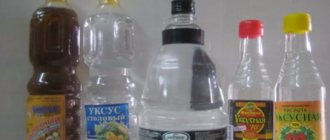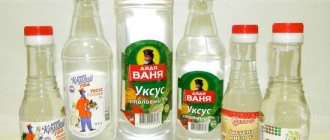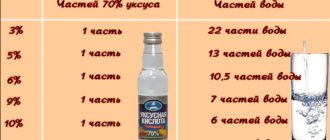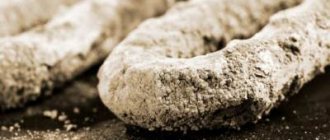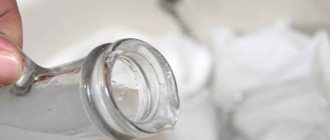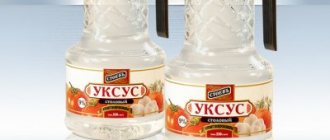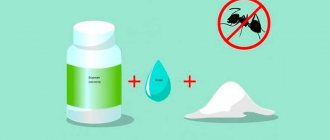Bite is an extremely important additive in cooking, without which we cannot make winter preparations, delicious marinades, all kinds of snacks, etc. But the most important thing here is to know when to stop so that the dish does not turn into inedible and harmful sourness, and for this it is important to be able to dilute the vinegar to the required concentration.
In recipes in the list of ingredients you can find: “vinegar essence”, “table vinegar”, vinegar 70%, 9%, 6% or 3%. Although all this is called the general word “vinegar,” these solutions are very different and should not be confused with each other. Let's briefly look at which of them is which.
There is an active substance called “acetic acid”; solutions of water and this acid can be found in stores.
- Acetic essence is a solution with an acid concentration of 70-80 percent.
Grocery stores usually stock 70 percent vinegar. Such a “strong” solution should be diluted, since in its pure form it poses a danger to the body; it is easy to overdo it with essence, thereby ruining the dish.
- There is also the so-called “table vinegar”. These are solutions with a concentration of acetic acid of 3-15 percent. More often in stores you can see 9% vinegar. Using this vinegar is very convenient; you can immediately scoop it into a spoon and add it wherever you need it.
It turns out that you need to keep 10 bottles of different vinegars at home? Some people do this, but in general, you can store one essence and simply dilute it at the right time. Below is all the detailed information on this topic.
What is vinegar essence
First, let's clarify what vinegar essence is. This is a 70% aqueous solution of acetic acid. This solution contains 7 parts acid and 3 parts water. Sometimes you can find 80% and 30% essence on sale. Accordingly, in the first the ratio of acid and water will be 8:2, and in the second – 3:7. Such concentrated solutions are dangerous; if taken orally, they cause burns to the mucous membranes of the digestive tract. In industrial production it is called the food additive E260, and housewives use it in the kitchen and for household purposes in the form of diluted table vinegar. Table vinegar is also sold in stores, its concentration ranges from 3% to 9%. In addition, on the shelves you can find vinegar made from natural raw materials: apple, wine, malt, balsamic, sherry and even coconut. This product is used for preparing culinary dishes.
And yet, the essence is most in demand for everyday needs. After all, from one teaspoon you can prepare a whole glass of table vinegar. Before we learn how to dilute vinegar essence 70%, let's focus on the quality of the original product.
Acetic acid is widely used in industry. An aqueous solution of acetic acid in the form of food additive E260 is used as a preservative. Moreover, unlike many other preservatives used, acetic acid in reasonable concentrations is considered safe for health. That is why it is common in home cooking and canning. Housewives often have to dilute acetic acid solutions to the desired concentration. How to do it right?
Concentrated acetic acid (concentration of about 100%) is called glacial and is not used in everyday life. Moreover, acetic acid with a concentration of more than 80% is included in the list of precursors whose circulation in the Russian Federation is limited. Attempts to purchase and use such acid can lead to serious trouble with the law.
Less concentrated solutions are sold completely freely. In stores you can buy vinegar essence (aqueous solution with a concentration of 70-80%), acetic acid solution (25-30%), table vinegar with a concentration of 3-9%. Such diversity often leads to the fact that recipes indicate a certain amount of acetic acid of one type, but a completely different one is available. But it doesn’t matter, everything can be easily calculated and replaced.
A less concentrated vinegar from a more concentrated one (for example, 9% vinegar from a 70% essence) can be obtained by diluting it with water. Water must be cool and clean, preferably filtered or distilled. It is impossible to obtain a more concentrated vinegar from a less concentrated one. However, in some cases (for example, the recipe indicates 70% essence, but only 9% table vinegar is available), you can simply take more of the weak solution. All calculations can be carried out using an interactive calculator for dilution schemes for aqueous solutions. It's very easy to use.
In most cases, breeding is carried out according to standard schemes, which are given below. The article uses “culinary” breeding schemes, expressed in parts. You can measure parts by teaspoons or tablespoons. It is also convenient to use a large 10 or 20 gram medical syringe.
How to get table vinegar 3%
3% vinegar is most often used for salad dressing. To obtain it you need to dilute:
- 1 part 80% vinegar essence to 25.7 parts water
- 1 part 70% vinegar essence to 22.3 parts water
- 1 part 30% acetic acid solution to 9 parts water
- 1 part 9% table vinegar to 2 parts water
How to get table vinegar 5%
5% vinegar is used for dressing salads and preparing sauces. To obtain it you need to dilute:
- 1 part 80% essence to 15 parts water
- 1 part 70% essence to 13 parts water
- 1 part 30% acetic acid solution to 5 parts water
- 1 part 9% table vinegar to 0.8 parts water
How to get table vinegar 6%
6% vinegar is most often used for marinating meat. To obtain it you need to dilute:
- 1 part 80% essence to 12.3 parts water
- 1 part 70% essence to 10.7 parts water
- 1 part 30% acetic acid solution to 4 parts water
- 1 part 9% table vinegar to 0.5 parts water
How to get table vinegar 9%
9% vinegar is used in canning. To obtain it you need to dilute:
- 1 part 80% essence to 7.9 parts water
- 1 part 70% essence and 6.8 parts water
- 1 part 30% acetic acid solution to 2.3 parts water
Vinegar 9% can be replaced with a less concentrated one:
- 1 part 9% vinegar can be replaced with 1.5 parts 6% vinegar
- 1 part 9% vinegar can be replaced with 3 parts 3% vinegar
How to get vinegar 10%
10% vinegar is used in canning. To obtain it you need to dilute:
- 1 part 80% essence to 7 parts water
- 1 part 70% essence and 6 parts water
- 1 part 30% acetic acid solution to 2 parts water
Vinegar 10% can be replaced with a less concentrated one:
- 1 part 10% vinegar can be replaced with 1.1 parts 9% vinegar
- 1 part 10% vinegar can be replaced with 1.7 parts 6% vinegar
- 1 part 10% vinegar can be replaced with 3.3 parts 3% vinegar.
How to get vinegar 25%
25% vinegar is used for household purposes. To obtain it you need to dilute:
- 1 part 80% essence to 2.2 parts water
- 1 part 70% essence to 1.8 parts water
How to get vinegar 30%
30% vinegar is used for household purposes. To obtain it you need to dilute:
- 1 part 80% essence to 1.7 parts water
- 1 part 70% essence and 1.3 parts water
How to replace vinegar essence 70%
70% vinegar is used for canning. Vinegar essence 70% can be replaced with less concentrated vinegar:
- 1 part of 70% vinegar essence can be replaced with 2.3 parts of a 30% acetic acid solution
- 1 part of 70% vinegar essence can be replaced with 2.8 parts of a 25% acetic acid solution
- 1 part 70% vinegar essence can be replaced with 7 parts 10% acetic acid solution
- 1 part 70% vinegar essence can be replaced with 7.8 parts 9% table vinegar
- 1 part 70% vinegar essence can be replaced with 11.7 parts 6% table vinegar
- 1 part 70% vinegar essence can be replaced with 14 parts 5% table vinegar
- 1 part of 70% vinegar essence can be replaced with 23.3 parts of 3% table vinegar
If the recipe uses water, its amount must be reduced by the amount of diluted vinegar added.
Be careful when working with concentrated solutions of acetic acid (more than 15%). Even acid vapors can cause burns to the skin and mucous membranes. Use personal protective equipment and work in a ventilated area. If acid gets on your skin, it should be washed off immediately with water. If acid gets into your eyes, rinse with plenty of water and consult a doctor.
We recommend reading
- Pie with apples? Of course, Charlotte!
- Quick cherry compote
- Buddhist cherry compote
- Chicken in soy sauce with peanuts and ginger
- How to salt pike caviar?
- Yeast dough pizza
- What is asparagus in Korean?
- How to make strawberry jam?
- How to sterilize jars for homemade preparations?
- How to make grape juice?
How to buy good quality vinegar
High-quality essence is sold only in glass bottles. There should be three convex rings on the neck of the bottle to warn visually impaired people that the product is dangerous for ingestion. There are also four horizontal stripes on the bottle; between the bottom two there is a manufacturer’s stamp on the inner surface of the glass. The label indicates the concentration of vinegar - 70%. When shaken, the contents foam, then within two to three seconds they become the same. If the bottle is counterfeit, the foam will last longer than ten seconds. Do not buy counterfeits, they are harmful to your health and, at best, will ruin your prepared dishes and preserves.
Usually the label gives very brief instructions on how to dilute vinegar essence. Manufacturers write that you need to dilute the original product with water one to twenty. To obtain a solution of different concentrations, the amount of starting ingredients will be different. You can use a mathematical formula.
How to dilute 9 percent vinegar to 6 percent and 3%
Diluted 9% vinegar often needs to be diluted to 6% or 3%; in other words, the existing 9% solution needs to be diluted. When diluting 9 percent vinegar, you can measure the liquid in milliliters or make calculations in grams. If you dilute two glasses of 9% vinegar with a glass of water, you get 6% table vinegar. Following this formula, it is easy to answer the question of how to dilute 9 percent vinegar to 3 percent, or how to make 6 percent vinegar from 9 percent. To dilute 70% acetic acid into solutions of other percentages, water will be required in certain proportions. You can find out how to dilute 70 percent vinegar from a convenient table.
Mathematical calculation
For those who are good with mathematics, the easiest way to dilute the essence to the required concentration is using the formula:
- The amount of essence required to obtain table vinegar = the desired concentration of the solution * the volume of the finished solution we need / the concentration of the essence.
For example: how to dilute vinegar essence to obtain 200 ml of 9% table vinegar.
9% * 200 ml / 70% = 25.7 ml of essence, add water to 200 ml.
In another option, you can go from the opposite.
- Amount of water required for dilution = amount of essence * concentration of essence / desired concentration of solution.
For example: it is necessary to dilute 15 ml of 70% vinegar essence to 6% table vinegar.
To do this, you need the following amount of water: 15 ml * 70% / 6% = 175 ml of water.
To measure volume, you can use a measuring cup or rely on the following numbers:
1 teaspoon = 5 ml, 1 dessert spoon = 10 ml, 1 tablespoon = 15-20 ml (depending on its depth). Classic faceted glass: full = 250 ml, rim = 200 ml, vodka shot glass = 50 ml.
For those who don’t want to bother with calculations, we suggest using standard coefficients.
How to make solutions of various concentrations at home
0
Source:
See all photos in the gallery
Concentrated vinegar 70% can be easily diluted with plain water. It’s easy and quick to make table vinegar of various strengths yourself at home, but you need to know the proportions of water and the ratio of acetic acid and essence to it. There is a simple way to make 9 percent vinegar from 70 percent vinegar. To get 9% vinegar, add two tablespoons of 70% vinegar to a faceted glass of water. Agree, with a glass on hand it is easier to dilute and understand how to dilute the 70% essence.
0
Source:
It is important to use vinegar diluted in a glass of water for its intended purpose. By following the clear instructions of the recipe, you will be able to protect yourself from the dangerous effects of undiluted acetic acid on the human body. There is a formula for diluting vinegar, but with its help you need to do the calculations yourself. For convenience, we suggest using a hint on how much water and essence you need to take:
0
Source:
By combining 1 part acid and 6 parts water, we get a 10% vinegar solution. How to dilute 70 vinegar to 9 percent? To obtain the required concentration, use a ratio of 1:7. To obtain 8 percent vinegar, mix 1 part vinegar with 8 parts water. For a 7% solution, a ratio of 1:9 is suitable. How to dilute vinegar 70 to 6? To get a 6% vinegar concentration, mix water and acid in a ratio of 11:1. Acetic essence and water in a ratio of 1:13 produces a 5% vinegar solution. Vinegar with a concentration of 4% is made from 17 parts water and 1 part acid. A 3% vinegar solution consists of 22.5 parts water and 1 part 70% vinegar essence.
How to make nine percent vinegar
Table vinegar of this concentration is used for canning food. How to dilute vinegar essence to obtain a solution with a concentration of 9%? It is necessary to dilute the essence with 70% water in the ratio: 1 part concentrate and 7 parts water. That is, for 0.5 liters of water you need to add 75 ml of essence (one and a half shot glasses).
A solution of table vinegar is recommended to be used as a rubdown for diseases accompanied by an increase in body temperature. How to dilute vinegar essence at temperature? Pour one liter of water into an enamel bowl and add 2 tbsp. l. 9% table or apple cider vinegar.
How is acetic acid obtained?
One of the most common industrial methods for producing acetic acid is the oxidation of acetaldehyde with atmospheric oxygen. The process is performed in the presence of a special catalyst - manganese acetate at a temperature of 50 to 60 ° C.
2CH3CHO + O2 → 2 CH3COOH
Previously, other methods for producing acetic acid were used, such as the oxidation of butane and acetaldehyde. Oxidation of acetaldehyde occurred in the presence of manganese at elevated pressure and temperature. The output could be 95% acetic acid.
But still, a natural acid is one that is obtained by fermentation. It can be grape or apple wine.
The properties of this substance may vary depending on the percentage of water in it. Because of this, for many centuries chemists believed that the acid from acetates and the acid from wine were two different substances. Naturally, this opinion was wrong. It all depends on the concentration of water.
How to make three percent vinegar
Table vinegar with a concentration of 3% is used to season ready-made dishes: salads, dumplings, pickled mushrooms, onions, sauces, etc.
How to properly dilute vinegar essence and get a three percent solution: take 22 parts of water for one part of essence. To prepare 0.5 liters of table vinegar you need 20 ml of vinegar essence 70%.
Dilute the essence in a glass or enamel container. First, the required amount of clean drinking water is measured into it. The water should be cool. Then add the calculated amount of vinegar essence. Avoid contact of the concentrate with the skin and especially with the mucous membranes of the eyes and mouth. But if such a nuisance does occur, rinse the affected area under cool running water. Store vinegar essence in a dark place out of reach of children. Remember, this is an acid and can be harmful to your health if not handled correctly.
First aid for poisoning with vinegar or vinegar essence.
If you have diluted acetic acid incorrectly, or are poisoned by acetic acid in some other way, then you must immediately resort to first aid. In case of contact with the eyes, they should be rinsed immediately, copiously and for a long time with cold water, then drip 1-2 drops of novocaine. After this, you need to drip special antibiotics, for example, a 0.25% solution of chloramphenicol.
Irritation of the upper respiratory tract can be eliminated by rinsing the throat and nose with cold water or inhaling a soda solution. It is also recommended to drink warm Borjomi water or milk with soda.
In case of contact with skin, rinse thoroughly with tap water. You can use soap or a 0.5-1% alkali solution. The burn site should be treated with a disinfectant solution, preferably furatsilin. Treat the burn site with disinfectant solutions, for example, furatsilin.
If a person drinks acetic acid, then immediate gastric lavage is necessary using a thick probe, which is lubricated with vegetable oil. It is recommended to add egg white or milk to cold water. The use of laxatives and soda is strictly prohibited. If gastric lavage fails, then the victim should drink 3-5 glasses of cold water and induce artificial vomiting. This procedure must be repeated 3-4 times. The use of emetics is contraindicated. You can take starch, beaten egg yolks, milk and mucous infusions orally. You can put something cold on your stomach. It is recommended to swallow small pieces of ice. To avoid painful shock, the victim should be administered strong analgesics (morphine, promedol). In a hospital setting, intensive therapy and symptomatic treatment are provided.
Precautionary measures
Acetic essence is a concentrated acid. It is poisonous to humans no matter how it is used. If it gets on the skin or mucous membranes, a chemical burn will follow. If you drink it, the tissue becomes necrotic, the composition of the blood changes and death occurs. Therefore, use extreme caution when working with this substance.
Basic safety rules:
- Store vinegar essence in a separate, well-sealed container.
- Do not leave a bottle of vinegar essence in accessible places for children, pets, or people with unstable mental health.
- When working with acid, always use gloves, do not lean close to the container with acid, and do not inhale the fumes.
- Do not swallow acid, do not allow it to come into contact with mucous membranes.
The use of diluted acetic acid requires extreme caution. Especially if the solution is taken orally. Can you drink apple cider vinegar and what are its benefits? Consult your doctor to find out exactly the beneficial properties and exclude possible contraindications. Do an allergy test.
And one last video on how to dilute and use concentrated acetic acid in everyday life.
Measuring table of vinegar in grams and milliliters “How much vinegar in a tablespoon and a teaspoon”
| How many tablespoons is this? | tablespoons | dessert spoons | teaspoons |
| 200 grams (ml.) vinegar | 13 | 1 | |
| 200 grams (ml.) vinegar | 20 | ||
| 150 grams (ml.) vinegar | 10 | ||
| 150 grams (ml.) vinegar | 15 | ||
| 100 grams (ml.) vinegar | 6 | 1 | |
| 100 grams (ml.) vinegar | 6 | 2 | |
| 100 grams (ml.) vinegar | 10 | ||
| 100 grams (ml.) vinegar | 20 | ||
| 90 grams (ml.) vinegar | 6 | ||
| 80 grams (ml.) vinegar | 5 | 1 | |
| 75 grams (ml.) vinegar | 5 | ||
| 70 grams (ml.) vinegar | 4 | 2 | |
| 70 grams (ml.) vinegar | 4 | 1 | |
| 65 grams (ml.) vinegar | 4 | 1 | |
| 60 grams (ml.) vinegar | 4 | ||
| 50 grams (ml.) vinegar | 3 | 1 | |
| 45 grams (ml.) vinegar | 3 | ||
| 40 grams (ml.) vinegar | 2 | 2 | |
| 40 grams (ml.) vinegar | 4 | ||
| 40 grams (ml.) vinegar | 8 | ||
| 35 grams (ml.) vinegar | 2 | 1 | |
| 30 grams (ml.) vinegar | 2 | ||
| 30 grams (ml.) vinegar | 3 | ||
| 30 grams (ml.) vinegar | 6 | ||
| 25 grams (ml.) vinegar | 5 | ||
| 20 grams (ml.) vinegar | 1 | 1 | |
| 20 grams (ml.) vinegar | 2 | ||
| 20 grams (ml.) vinegar | 4 | ||
| 15 grams (ml.) vinegar | 1 | ||
| 10 grams (ml.) vinegar | 1 | ||
| 5 grams (ml.) vinegar | 1 |
Most often you can find table vinegar or just vinegar in stores. The most popular of them are 3% , 6% and 9% . Three and six percent vinegar is most often used for salads. Nine percent ( 9% ) vinegar is usually used for marinades.
If you liked our vinegar measurement chart, please check out our most comprehensive food measurement chart.
Acetic essence 70% converted to 9% vinegar: table
Before looking for information on converting 70% acetic acid into 9% vinegar, pay attention to the vinegar dilution table with ready-made calculations on how to make 9% vinegar from 70% vinegar. A table of the concentration of vinegar 70% and the ratio of one part of it to parts of water will help you independently obtain a correctly diluted solution: Example: 3% vinegar is obtained from 1 part vinegar and 22 parts water; 4% – 1:17; 5% – 1:13; 6% – 1:11; 7% – 1:9; 8% – 1:8; 9% – 1:7; 10% – 1:6; 30% – 1:1.5; 40% – combine with 0.8 part of water.
How to use citric acid for canning.
Most often in recipes you can find 2 tablespoons of bottled lemon juice or 1/2 teaspoon of lemon powder per 1 liter of water or for ready-made canned food per liter jar. For a half-liter jar (for example, tomato juice ), you will need 1 tablespoon of lemon juice from a bottle or 1/4 teaspoon of dry lemon powder.
Please note that bottled lemon juice and freshly squeezed lemon juice are not the same thing. And to dress the salad, instead of one tablespoon of 6% vinegar, you will need two tablespoons of freshly squeezed lemon juice.
In what proportions should you dilute citric acid per liter?
For use in cooking, acid in liquid form is more popular, but in stores it is sold exclusively in powder form. How to make 1 liter of concentrated solution from it.
Products and inventory:
- citric acid (powder) – 500 g;
- filtered water – 1 l;
- containers that will not oxidize during the cooking process. It is important that it is sterilely clean.
The prepared amount of powder must be poured into a suitable container. In a separate container, bring water to a boil. This can be done on the stove or in the microwave. In the latter case, you need to remember that during boiling the liquid can overflow. It is for this reason that this process must be carefully monitored.
Add water to the powder while stirring regularly. You should use a plastic spoon. Strain the resulting solution through cheesecloth and a sieve. Wait until it cools down completely. Pour the composition into a suitable container. Keep refrigerated. If necessary, the concentrated solution is diluted with water.
In what cases is it necessary to dilute vinegar?
At home, acetic acid is often used in cooking and as a traditional medicine. In diluted form, it is used externally to treat joints, heel spurs, and reduce elevated body temperature with vinegar compresses. For cosmetic purposes, a low concentration solution is used to rinse hair. The vinegar solution is used to wipe the skin of the face and body; people drink apple cider vinegar to lose weight.
Diluted vinegar is included in mixtures against pests of cabbage, currants and indoor plants. The vinegar solution has an effective effect on tomatoes; gardeners use it to prevent late blight, against aphids on cucumbers, and to treat bell pepper ovaries against pests.
If you dilute vinegar correctly, its solution is suitable for any purpose. Vinegar inherently has a wide range of applications; it is used for various purposes. The sour-tasting solution serves as an indispensable seasoning for dumplings.
Diluted and undiluted 70% vinegar is added as a preservative for preparing homemade squash caviar for the winter, when marinating champignons in jars, wild mushrooms for future use and vegetables. As the main ingredient, vinegar can be found in almost all recipes for marinades of cabbage, meat kebabs with onions, and preparing sushi rice.
Table vinegar (9%) can be replaced with apple cider vinegar.
But you need to understand that apple cider vinegar is sold at 5%, that is, to use it instead of 9% vinegar, you will need 2 times more apple cider vinegar. Instead of 1 tablespoon of 9% vinegar, take 2 tablespoons of apple cider vinegar.
Apple cider vinegar, grape (wine), rice vinegar, balsamic vinegar and others are most often used NOT for canning, but for dishes (borscht, salads, dressings) or marinating meat and fish. Since they still have their own specific taste, introduce them into your family’s diet carefully, because as you know, we are often conservative in our tastes, especially children.
You need to be even more careful if someone in the family has gastritis, ulcers or colitis, as well as

